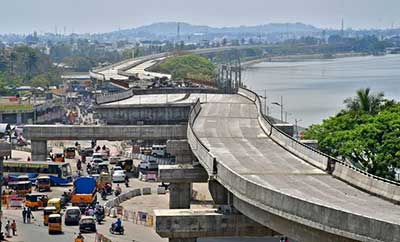Date: 01/03/2023
Relevance: GS-2: Government Policies and Interventions for Development in various sectors and Issues arising out of their Design and Implementation.
Relevance: GS-3: Infrastructure: Physical and Digital Infrastructure.
Key Phrases: Physical and Digital Infrastructure, Infrastructure Finance Secretariat, Big Data, Open Network for Digital Commerce (ONDC), Airport, National Highways, Projection of Traffic Volume, National Logistic Policy, National Infrastructure Pipeline, PM Gati-Shakti.
Context:
- In India, the last eight years have seen tremendous progress in the
areas of infrastructural development.
- Among the infrastructure segments, investment in transport corridors (land, water, rail, air) and digital infrastructure have been the focal theme of the government for successive years.
Key Highlights:
- The newly-established Infrastructure Finance Secretariat will be key to assisting all stakeholders for more private investment in infrastructure, including railways, roads, urban infrastructure and power, which are predominantly dependent on public resources.
- Currently, India has over 1.4 lakh km of highways throughout the country.
- The government has undertaken several structural reforms to make the entire infrastructure pipeline visible and viable.
Infrastructural Progress in India:
- National Infrastructure Pipeline:
- Building on the mixed success derived from private participation in infrastructure programmes supported through PPP models like BoT, ToT, etc., the government launched the National Infrastructure Pipeline to channelise dedicated credit support for world class infrastructure across the country.
- Holistic and Integrated Approach:
- For a holistic and integrated approach to infrastructure planning and development, the government instituted two strong pillars: PM GatiShakti and National Logistics Policy.
- The aim is to upgrade the existing infrastructure by crowding-in domestic and foreign private-sector investment which ultimately leads to logistical efficiency, addresses critical gaps for seamless completion of infrastructure projects, minimizes disruptions, and ensures timely completion of works.
- Multi-modal Transportation:
- While roads, railways, and waterways have seen unprecedented
expansion, the ports and airports have been substantially upgraded.
- Simultaneously, the nation has moved from unimodal to multi-modal transportation.
- Facilitating a swift, efficient, economical and environment-friendly logistics movement across the country, this approach provides the private sector the opportunity to invest and reinvest, which the government has already facilitated by envisaging the transfer of assets (through monetisation) to their counterpart.
- While roads, railways, and waterways have seen unprecedented
expansion, the ports and airports have been substantially upgraded.
- Digital Public Infrastructure:
- With the vision of a $1 trillion digital economy by 2025, the government is marching towards providing new e-governance-based services and modifying the existing ones on a need basis.
- The bouquet of digital public infrastructure products like e-RUPI, e-way bill, TReDS for MSMEs, etc., have ensured real value for money to consumers and has also reduced the compliance burden for producers.
- The nation at large benefited from the transformed payment infrastructure via UPI and Aadhaar-enabled payment system, firmly placing India on the track towards a cashless economy.
- Open Network for Digital Commerce (ONDC):
- It is a revolutionary step forward towards democratization and decentralizing digital commerce through a set of standards.
- It has the potential to transform how businesses and consumers presently interact, by giving greater thrust to penetration of e-retail commerce in the country.
Budget’s Push for Infrastructure:
- Digital Infrastructure:
- The announcement in the Budget about the National Data Governance Policy towards enabling access to anonymised data is a positive footstep.
- Physical Infrastructure:
- Roads, transport and the Railways continue to remain in focus of the government's successive budgets.
- The Railways received the highest ever outlay of ₹2.4-lakh crore
in FY24, nearly nine times of that in FY14.
- The funds will mostly be spent on building tracks, new coaches, electrification, and developing facilities at stations.
- The government has decided to raise the allocation towards the roads ministry by some 36 percent to Rs 2.7 lakh crore for 2023-24.
- As per the Economic survey 2022-23, the civil aviation sector has
great potential owing to growing demand from the middle class,
growth in population and tourism, higher disposable incomes, favorable
demographics, and greater penetration of aviation infrastructure.
- The finance minister has allocated Rs 3,113.36 crore to the civil aviation ministry this year.
- There is also focus on reviving 50 additional airports, heliports, water aerodromes and advance landing groundings for improving regional air connectivity.
Way Forward:
- Under the vision of Digital India, the government has rolled out
futuristic infrastructure in the form of smart cities based on the
interlocking of physical and digital aspects.
- This synergy will transform India into a middle-income economy, thereby creating assets that cater to the needs of the future.
- There is an urgent need for much attention paid to correctly project
the future stream of traffic (freight, passenger).
- In most project documents, the methodology is not spelt out clearly.
- Developed countries' methods can be followed for projecting
the stream of traffic.
- In developed countries, sufficient attention is paid to projecting traffic volume at the planning stage itself.
- They make use of Big Data to understand the existing volume of traffic on a corridor.
- India generates Big Data (24x7) on freight transport movement —
that is, GST/E-way bill — which is not released by the government
for planning purposes.
- Ideally, the government can anonymise and release this data.
- The data must be made available to independent researchers as this will facilitate a more accurate estimation of logistics cost which policymakers are planning to measure on a regular basis.
Conclusion:
- Despite global adversity, India’s economy, digital economy and the overall ecosystem have continued to grow and prosper.
- Government’s push towards infrastructure is in tune with the government’s objective to build an efficient logistics ecosystem to make India a hub of the global value chain.
Source: The Hindu BL
Mains Question:
Q. "Progress in physical and digital infrastructure is raising the growth potential of India". In light of this statement, analyze the progress made in the infrastructure sector of India. (250 Words).







